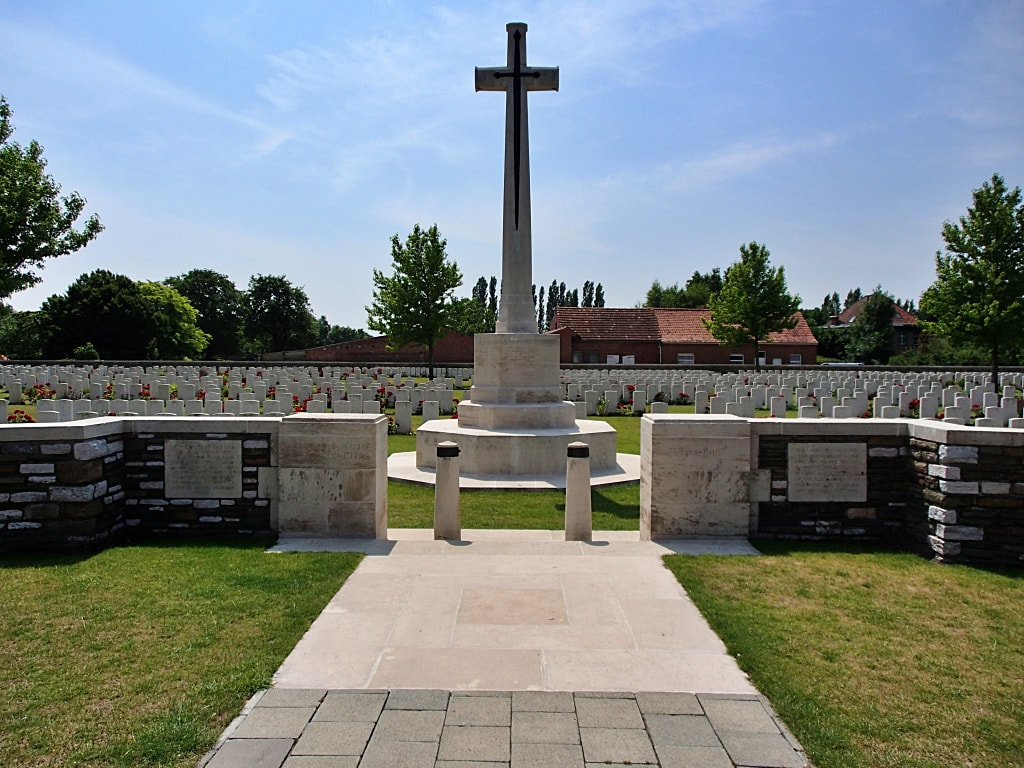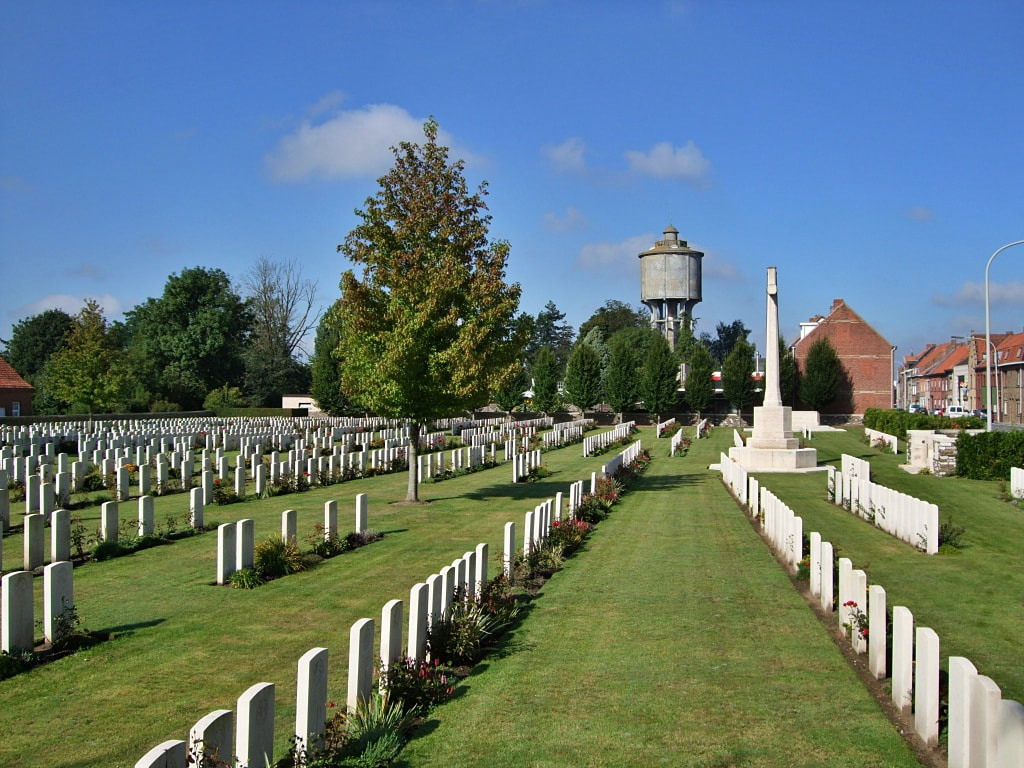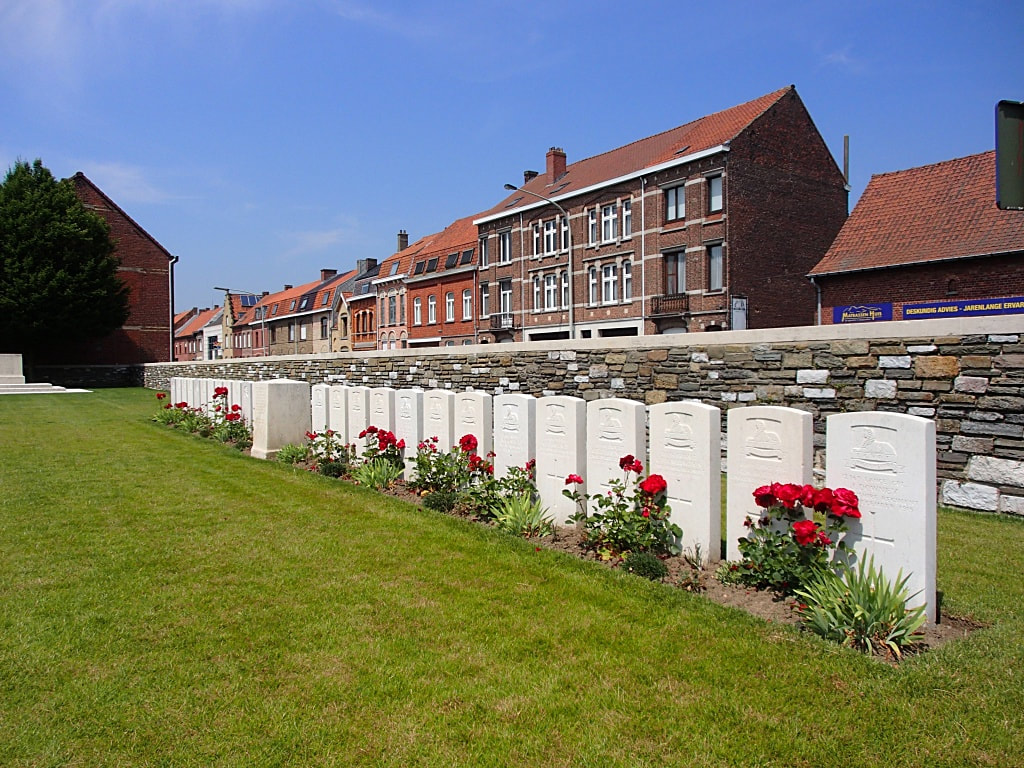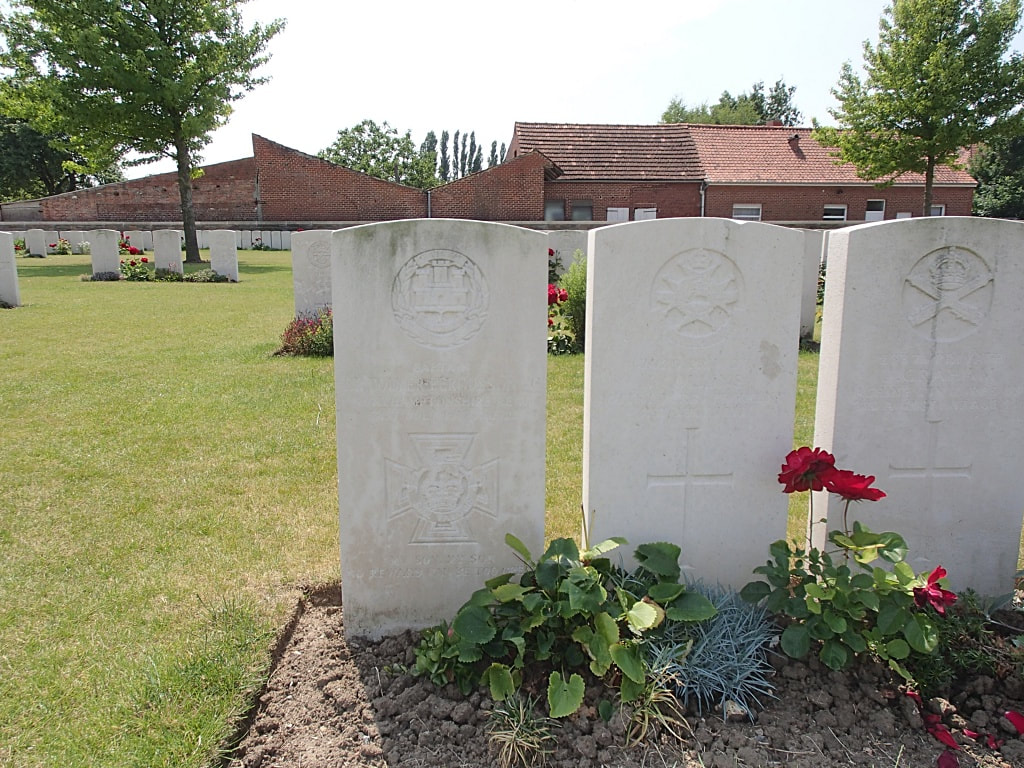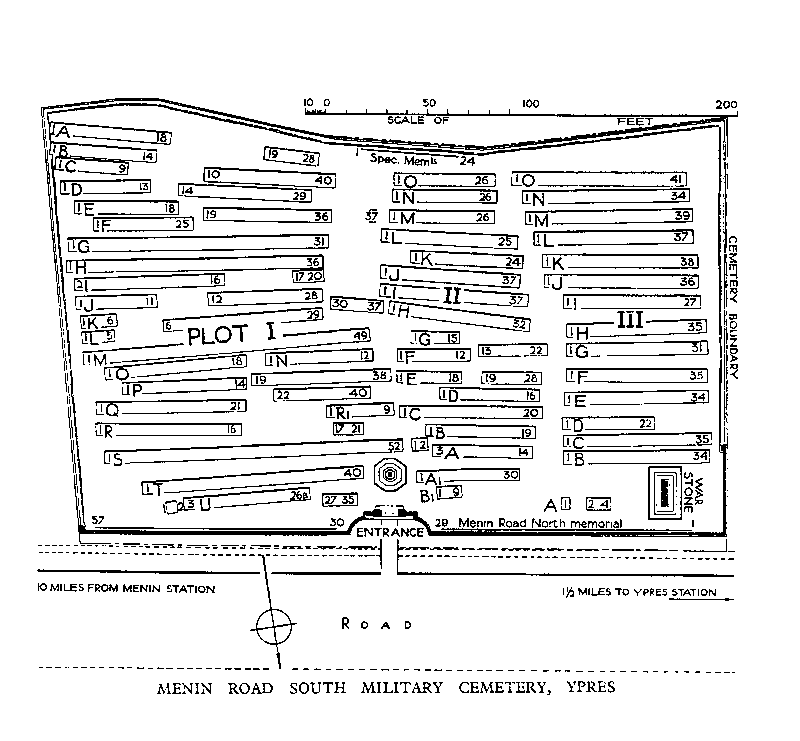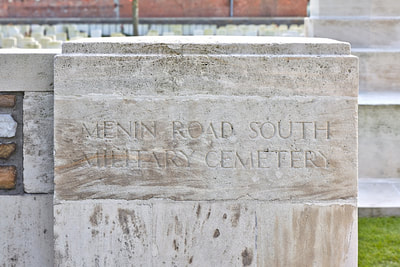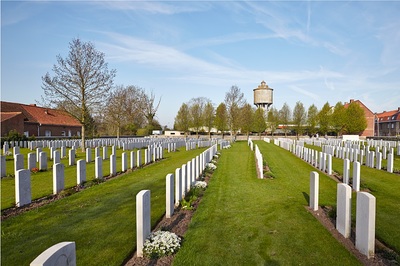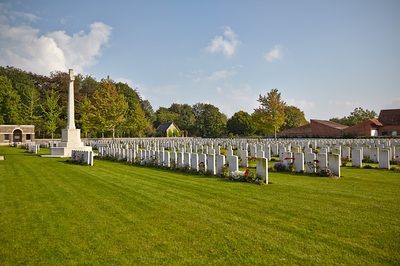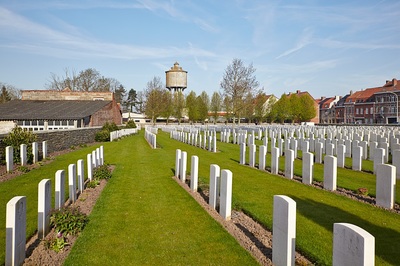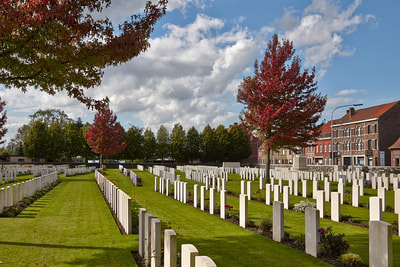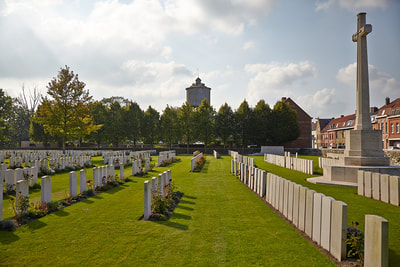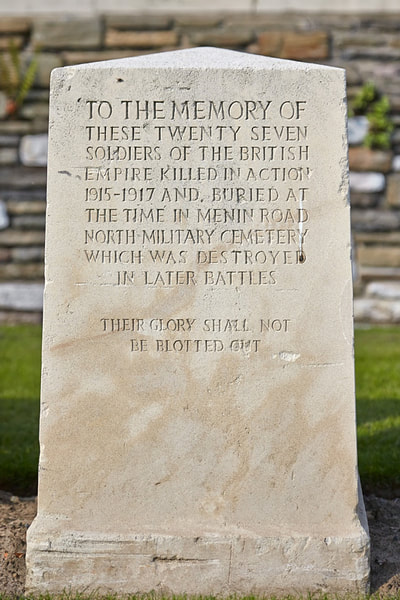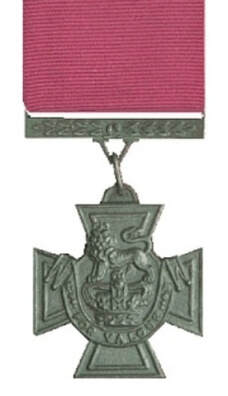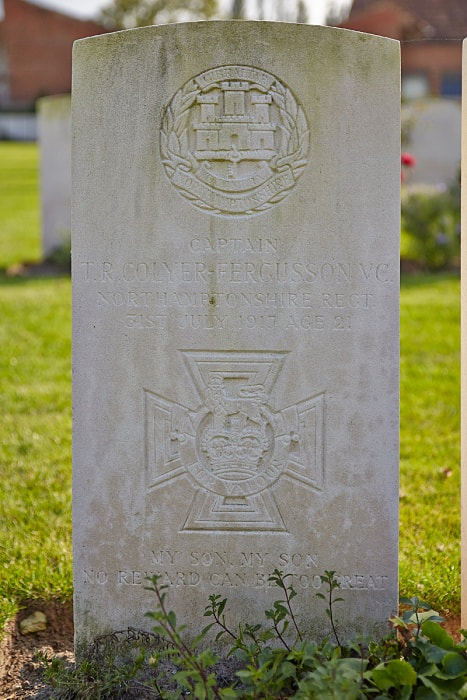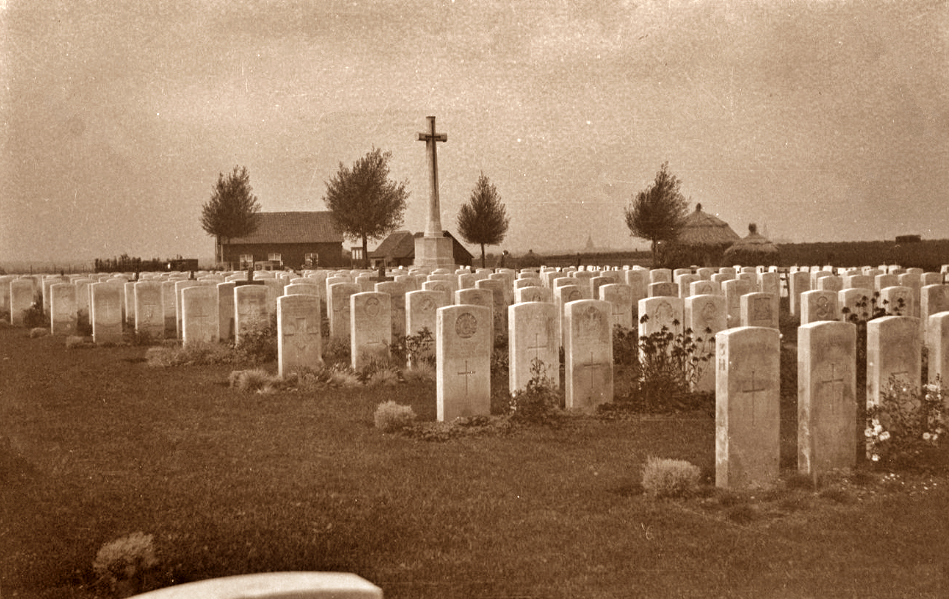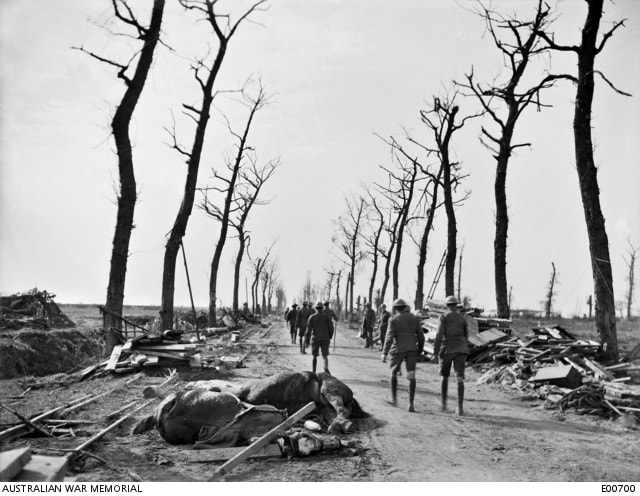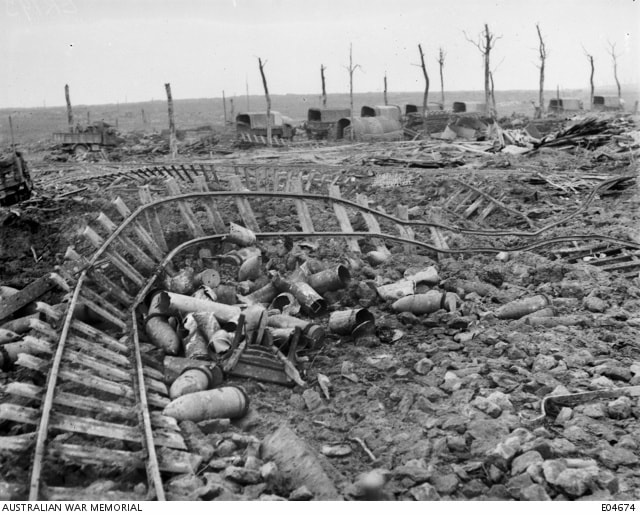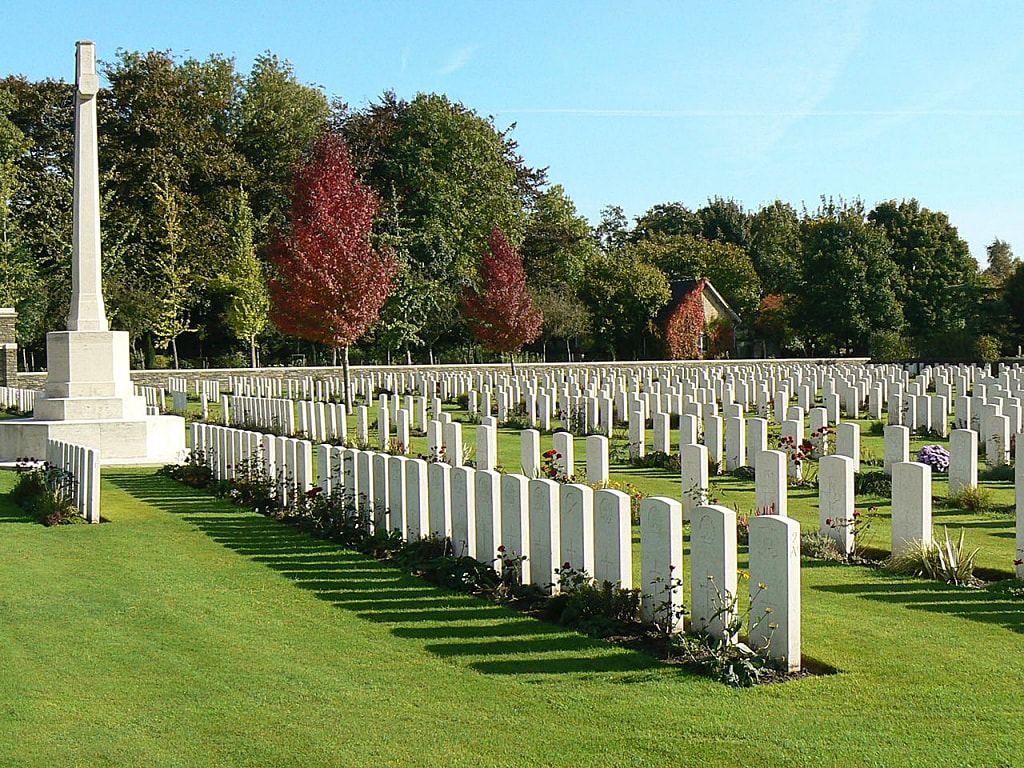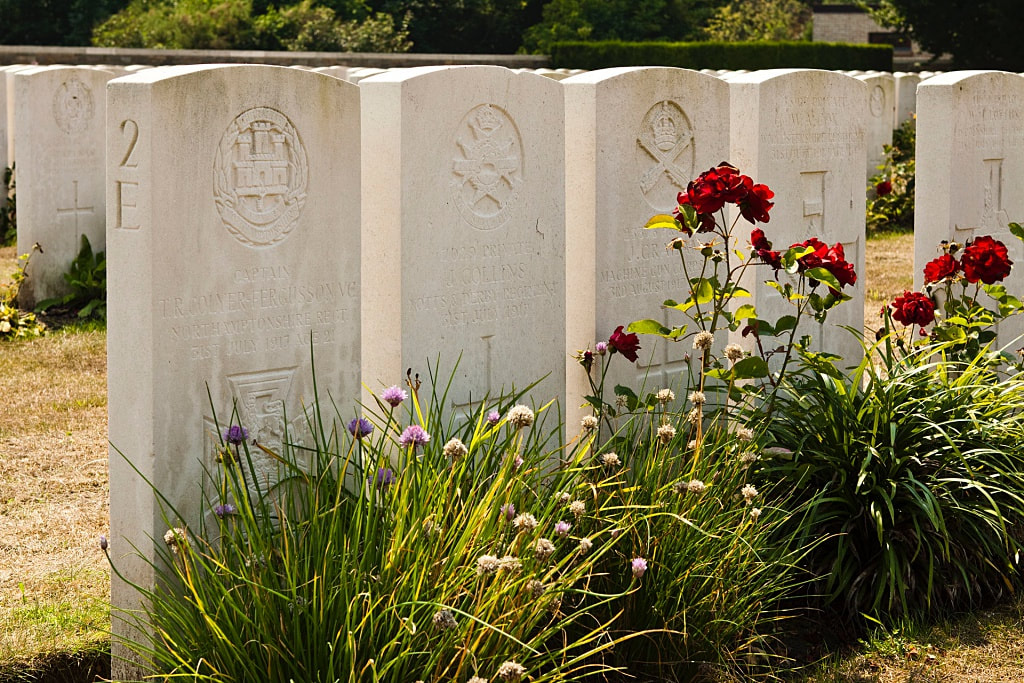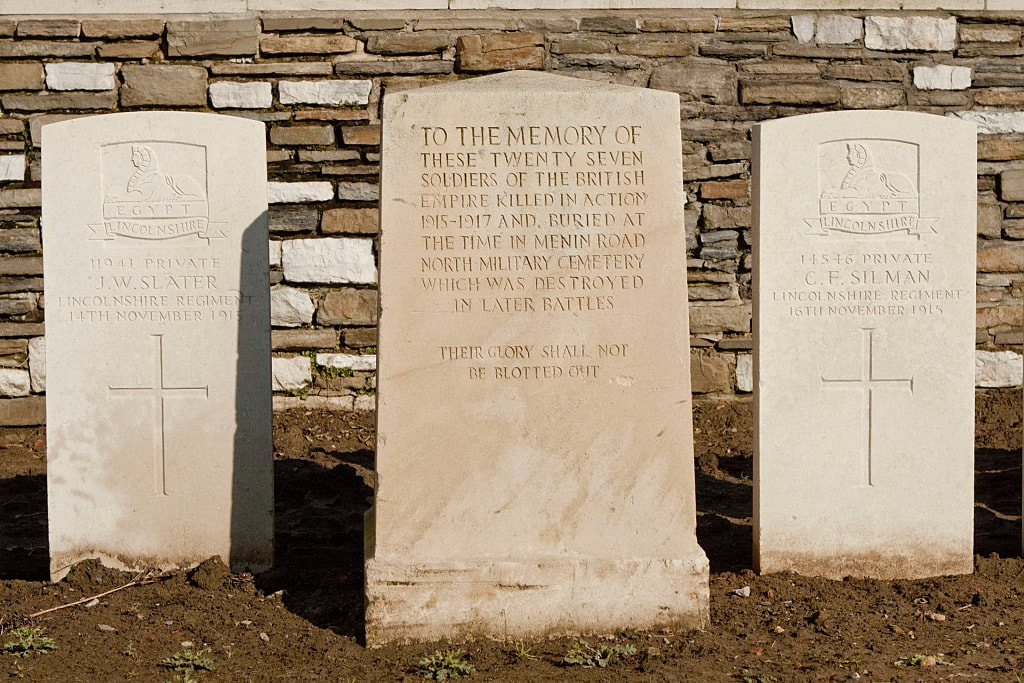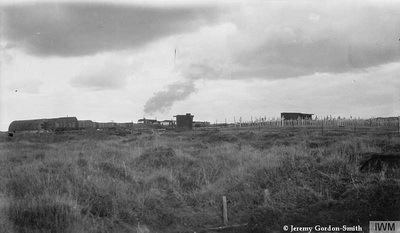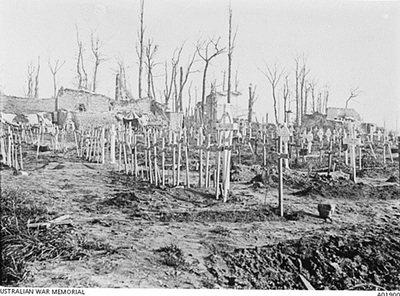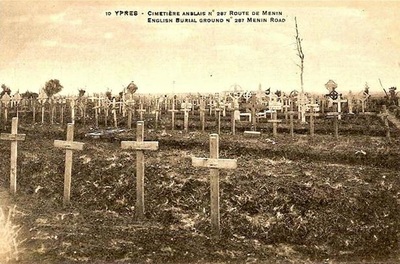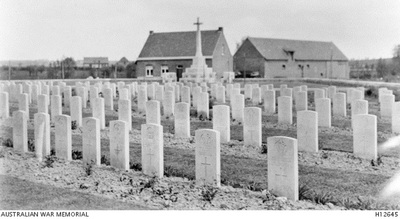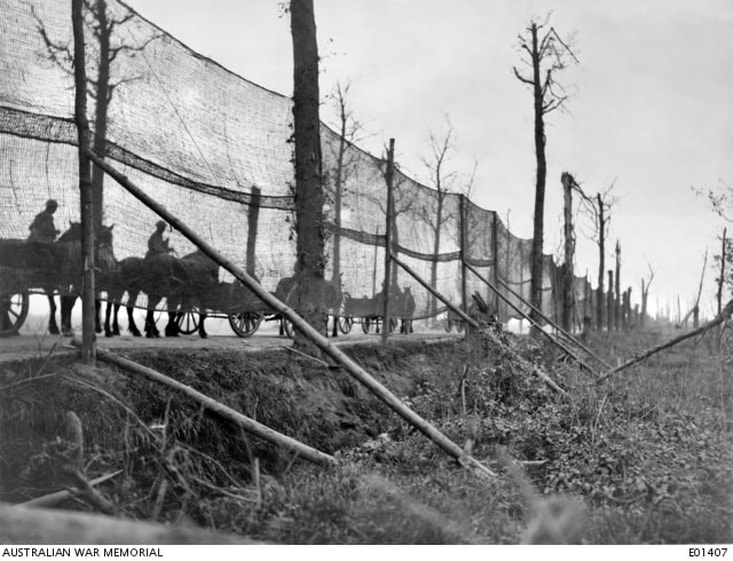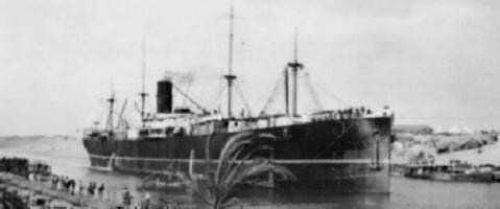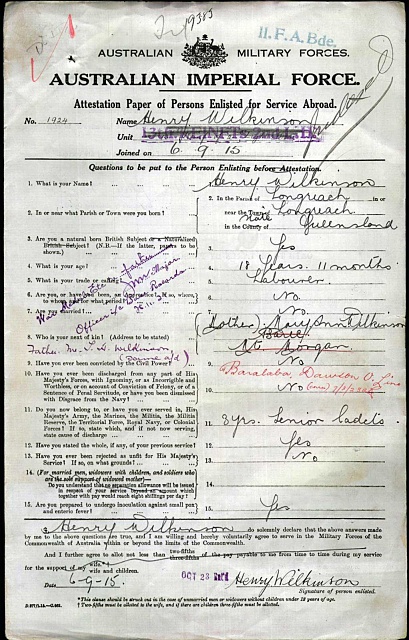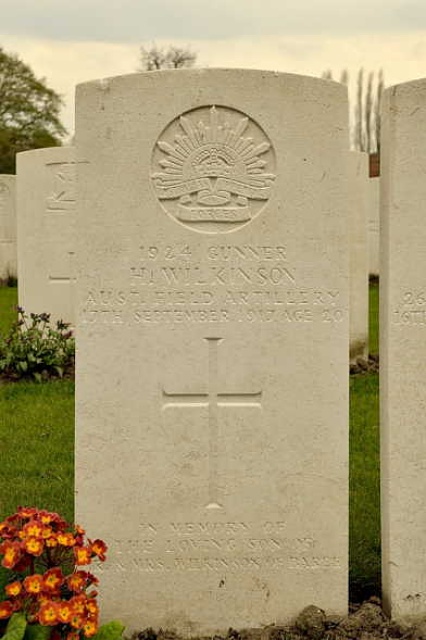MENIN ROAD SOUTH MILITARY CEMETERY
West-Vlaanderen
Belgium
GPS Coordinates: Latitude: 50.84982 Longitude: 2.90472
Location Information
Menin Road South Military Cemetery is located 2 Kms east of Ieper town centre, on the Meenseweg (N8), connecting Ieper to Menen.
From Ieper town centre the Meenseweg is located via Torhoutstraat and right onto Basculestraat. Basculestraat ends at a main crossroads, directly over which begins the Meenseweg. The Cemetery is located 800 metres along the Meenseweg on the right hand side of the road.
Visiting Information
Wheelchair access to site possible, but may be by an alternative entrance.
Historical Information
The Menin Road ran east and a little south from Ypres (now Ieper) to a front line which varied only a few kilometres during the greater part of the war. The position of this cemetery was always within the Allied lines. It was first used in January 1916 by the 8th South Staffords and the 9th East Surreys, and it continued to be used by units and Field Ambulances until the summer of 1918. The cemetery was increased after the Armistice when graves were brought in from isolated positions on the battlefields to the east and the following cemetery:-
MENIN ROAD NORTH MILITARY CEMETERY was on the North side of the road at almost the same point. It was used by the units and Field Ambulances of another Corps from May, 1915, to August, 1916, and again to a small extent in 1917 and 1918. It contained the graves of 130 soldiers from the United Kingdom, three from Canada, and three from Newfoundland.
There are now 1,658 servicemen of the First World War buried or commemorated in this cemetery. 118 of the burials are unidentified but special memorials are erected to 24 casualties known or believed to be buried among them. In addition, there are special memorials to 54 casualties who were buried in Menin Road North Military Cemetery, whose graves were probably destroyed by shell fire and could not be found. These are numbered between 1 and 57.
Total Burials: 1,658.
Identified Casualties: United Kingdom 1,081, Australia 261, Canada 146, New Zealand 52. Total 1,540.
Unidentified Casualties: 118.
The cemetery was designed by Sir Reginald Blomfield and Captain Wilfred Clement Von Berg, M. C.
Menin Road South Military Cemetery is located 2 Kms east of Ieper town centre, on the Meenseweg (N8), connecting Ieper to Menen.
From Ieper town centre the Meenseweg is located via Torhoutstraat and right onto Basculestraat. Basculestraat ends at a main crossroads, directly over which begins the Meenseweg. The Cemetery is located 800 metres along the Meenseweg on the right hand side of the road.
Visiting Information
Wheelchair access to site possible, but may be by an alternative entrance.
Historical Information
The Menin Road ran east and a little south from Ypres (now Ieper) to a front line which varied only a few kilometres during the greater part of the war. The position of this cemetery was always within the Allied lines. It was first used in January 1916 by the 8th South Staffords and the 9th East Surreys, and it continued to be used by units and Field Ambulances until the summer of 1918. The cemetery was increased after the Armistice when graves were brought in from isolated positions on the battlefields to the east and the following cemetery:-
MENIN ROAD NORTH MILITARY CEMETERY was on the North side of the road at almost the same point. It was used by the units and Field Ambulances of another Corps from May, 1915, to August, 1916, and again to a small extent in 1917 and 1918. It contained the graves of 130 soldiers from the United Kingdom, three from Canada, and three from Newfoundland.
There are now 1,658 servicemen of the First World War buried or commemorated in this cemetery. 118 of the burials are unidentified but special memorials are erected to 24 casualties known or believed to be buried among them. In addition, there are special memorials to 54 casualties who were buried in Menin Road North Military Cemetery, whose graves were probably destroyed by shell fire and could not be found. These are numbered between 1 and 57.
Total Burials: 1,658.
Identified Casualties: United Kingdom 1,081, Australia 261, Canada 146, New Zealand 52. Total 1,540.
Unidentified Casualties: 118.
The cemetery was designed by Sir Reginald Blomfield and Captain Wilfred Clement Von Berg, M. C.
Images in this gallery © Geerhard Joos
Captain Thomas Riversdale Colyer-Fergusson, V. C.
2nd Bn. Northamptonshire Regiment
Killed in action on 31st July 1917 aged 21.
Plot II. E. 1.
Son of Thomas Colyer Colyer-Fergusson and the late Beatrice Stanley Colyer- Fergusson, of Ightham Mote, Sevenoaks, Kent. Born in London. His brother Max Christian Hamilton Colyer-Fergusson fell in the 1939-1945 War and is buried in IField (ST. Margaret Churchyard), Cobham, Surrey.
His headstone bears the inscription "My Son My Son No Reward Can Be Too Great"
Citation
An extract from "The London Gazette," No. 30272, dated 4th Sept., 1917; records the following:- "For most conspicuous bravery, skilful leading and determination in attack. The tactical situation having developed contrary to expectation, it was not possible for his company to adhere to the original plan of deployments, and owing to the difficulties of the ground and to enemy wire, Captain Colyer-Fergusson found himself with a Serjeant and five men only. He carried out the attack nevertheless, and succeeded in capturing the enemy trench and disposing of the garrison. His party was then threatened by a heavy counter-attack from the left front, but this attack he successfully resisted. During this operation, assisted by his Orderly only, he attacked and captured an enemy machine gun and turned it on the assailants, many of whom were killed and a large number driven into the hands of an adjoining British unit. Later, assisted only by his Serjeant, he again attacked and captured a second enemy machine gun, by which time he had been joined by other portions of his company, and was enabled to consolidate his position. The conduct of this officer throughout forms an amazing record of dash, gallantry and skill, for which no reward can be too great, having regard to the importance of the position won. This gallant officer was shortly afterwards killed by a sniper."
Headstone
Then and Now

20th September 1917; A group of German prisoners, taken by Australian troops, making their way towards the Menin Gate, following the capture of many German troops during the attack launched that morning. Soldiers, leading a line of packhorses, are seen heading in the opposite direction towards the front line. The ruins of Ypres can be seen in the background. Note the light railway line along the side of the road, which was used for transporting troops and supplies.

20th September 1917; Stretcher cases being sent away from the Third Divisional advanced dressing station at Halfway House on the Menin Road. The wounded were battle casualties from the attack earlier that morning by the 1st and 2nd Australian Divisions upon the Glencorse Wood, Nonne Bosschen and Polygon Wood.
Images in this gallery © Werner Van Caneghem

3621 Sergeant
Eric Arthur Allsopp, M. M.
18th Bn. Australian Infantry, A. I. F.
8th October 1917, aged 23.
Plot II. J. 37
From Auburn, NSW. A labourer prior to enlisting, he embarked from Sydney aboard HMAT Aeneas (A60) on 20 December 1915. Sgt. Allsopp was recommended for a Victoria Cross following his actions at Malt Trench, near Baupame, France on 26 February 1917. Although badly wounded, he kept the enemy at bay while his company retreated to safety. The award of a Military Medal was gazetted on 11 May 1917. On 7 October 1917, at Ypres, Belgium, he was wounded in action. On 8 October 1917, he died of his wounds at the 6th Australian Field Ambulance Station, Belgium, aged 23.
Eric Arthur Allsopp, M. M.
18th Bn. Australian Infantry, A. I. F.
8th October 1917, aged 23.
Plot II. J. 37
From Auburn, NSW. A labourer prior to enlisting, he embarked from Sydney aboard HMAT Aeneas (A60) on 20 December 1915. Sgt. Allsopp was recommended for a Victoria Cross following his actions at Malt Trench, near Baupame, France on 26 February 1917. Although badly wounded, he kept the enemy at bay while his company retreated to safety. The award of a Military Medal was gazetted on 11 May 1917. On 7 October 1917, at Ypres, Belgium, he was wounded in action. On 8 October 1917, he died of his wounds at the 6th Australian Field Ambulance Station, Belgium, aged 23.

11846 Private
H. Bull
1st Bn. Coldstream Guards
3rd April 1916.
Plot I. L. 16.
H. Bull
1st Bn. Coldstream Guards
3rd April 1916.
Plot I. L. 16.

1574 Driver
Patrick Hugh Egan
4th Brigade, Australian Field Artillery
30th September 1917, aged 24.
Plot II. I. 2.
Son of Charles Henry and Elizabeth Egan, of The Post Office, Aramac, Queensland.
Patrick Hugh Egan was born in Aramac, Queensland to Charles Henry Egan and Elizabeth (nee Wilkinson) He had 5 brothers and 6 sisters. Patrick never married. He Enlisted 17th Aug 1915 at Barcaldine, Queensland, Australia.
Patrick Hugh Egan
4th Brigade, Australian Field Artillery
30th September 1917, aged 24.
Plot II. I. 2.
Son of Charles Henry and Elizabeth Egan, of The Post Office, Aramac, Queensland.
Patrick Hugh Egan was born in Aramac, Queensland to Charles Henry Egan and Elizabeth (nee Wilkinson) He had 5 brothers and 6 sisters. Patrick never married. He Enlisted 17th Aug 1915 at Barcaldine, Queensland, Australia.
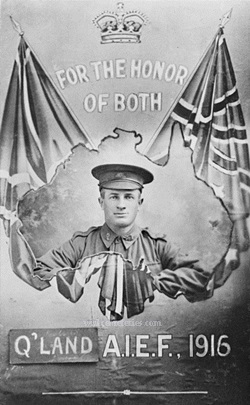
5374 Lance Corporal
Charles Joseph Mestrez
1st Coy. Australian Tunnelling Corps.
25th September 1917, aged 35.
Plot I. S. 35.
Son of Charles Joseph and Lucie Mestrez, of Alpha, Queensland. Native of Port Douglas, Queensland.
A 33 year old miner and clerk prior to enlisting on 10 April 1916, he embarked for overseas with the September 1916 Reinforcements from Melbourne on 29 September 1916 aboard HMAT Suffolk. He was killed in action on 25 September 1917 near Passchendaele, Belgium.
The image is inscribed "For the Honor of both Q'LAND A.I.E.F. 1916" referring to Queensland and the Australian Imperial Expeditionary Force.
Charles Joseph Mestrez
1st Coy. Australian Tunnelling Corps.
25th September 1917, aged 35.
Plot I. S. 35.
Son of Charles Joseph and Lucie Mestrez, of Alpha, Queensland. Native of Port Douglas, Queensland.
A 33 year old miner and clerk prior to enlisting on 10 April 1916, he embarked for overseas with the September 1916 Reinforcements from Melbourne on 29 September 1916 aboard HMAT Suffolk. He was killed in action on 25 September 1917 near Passchendaele, Belgium.
The image is inscribed "For the Honor of both Q'LAND A.I.E.F. 1916" referring to Queensland and the Australian Imperial Expeditionary Force.
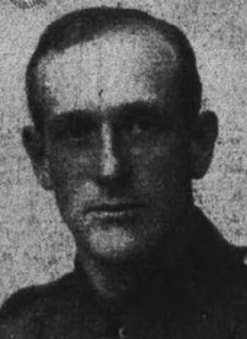
108497 Private
Jack Robinson
2nd Canadian Mounted Rifles Battalion
25th March 1916.
Plot I. D. 26.
Jack Robinson
2nd Canadian Mounted Rifles Battalion
25th March 1916.
Plot I. D. 26.
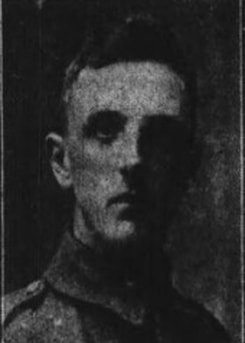
28191 Private
Edward Stephenson
2nd Bn. South Lancashire Regiment
12th August 1917.
Special Memorial 20.
Edward Stephenson
2nd Bn. South Lancashire Regiment
12th August 1917.
Special Memorial 20.

1924 Gunner
Henry Wilkinson
11th Brigade, Australian Field Artillery
17th September 1917, aged 20.
Plot I. U. 17.
Son of Thomas Henry and Mary Ann Wilkinson, of Baree, Mount Morgan Lane, Central Queensland. Native of Baree, Oueensland.
Henry was born 23 September 1896 in Longreach, Queensland, Australia to Thomas Henry Wilkinson and Mary Ann Ross. He had 4 brothers and 4 sisters. He spent most of his life at Baree, Mount Morgan Queensland.
His records show he was 5 feet 2 ins, grey eyes and brown hair. Henry enlisted at nearby Rockhampton Queensland on the 6th September, 1915 at the age of 18 years. Prior to enlistment he spent 3 years in Senior Cadets. Occupation was that of a Labourer
Military Records show:
Trooper with 1st Light Horse Brigade, 2nd Light Horse Regiment 13th Reinforcements.
Served with 2nd Light Horse Regiment 13th Reinforcements, 1st Light Horse Reserve Regiment, 4th Div Artillery,
11th Aust Field Artillery Brigade mustered Gunner & posted to 41st Battery,
4th D.A.C, 11th Aust Field Artillery
Brigade 41st Battery
Pictures and information courtesy of Cynthia Egan
Henry Wilkinson
11th Brigade, Australian Field Artillery
17th September 1917, aged 20.
Plot I. U. 17.
Son of Thomas Henry and Mary Ann Wilkinson, of Baree, Mount Morgan Lane, Central Queensland. Native of Baree, Oueensland.
Henry was born 23 September 1896 in Longreach, Queensland, Australia to Thomas Henry Wilkinson and Mary Ann Ross. He had 4 brothers and 4 sisters. He spent most of his life at Baree, Mount Morgan Queensland.
His records show he was 5 feet 2 ins, grey eyes and brown hair. Henry enlisted at nearby Rockhampton Queensland on the 6th September, 1915 at the age of 18 years. Prior to enlistment he spent 3 years in Senior Cadets. Occupation was that of a Labourer
Military Records show:
Trooper with 1st Light Horse Brigade, 2nd Light Horse Regiment 13th Reinforcements.
Served with 2nd Light Horse Regiment 13th Reinforcements, 1st Light Horse Reserve Regiment, 4th Div Artillery,
11th Aust Field Artillery Brigade mustered Gunner & posted to 41st Battery,
4th D.A.C, 11th Aust Field Artillery
Brigade 41st Battery
Pictures and information courtesy of Cynthia Egan

20th September 1917; An unidentified stretcher case being attended to at an advanced dressing station of the 3rd Australian Field Ambulance, near the Menin Road at Ypres. Identified, left to right: Major D Mackenzie DSO; 13780 Private (Pte) R J Garlick; 18042 Pte W Baird; 91 Pte A W Ferguson; Captain O A Field; 66 Pte J Thomasson.

Two unidentified Scottish soldiers standing on the road side near a post located on the Menin Road. During the Third Battle of Ypres wounded were collected here for removal to a Dressing Station. Note a motor ambulance in the background (centre right) and the Union Jack and Red Cross flags flying above the collecting post building (left).
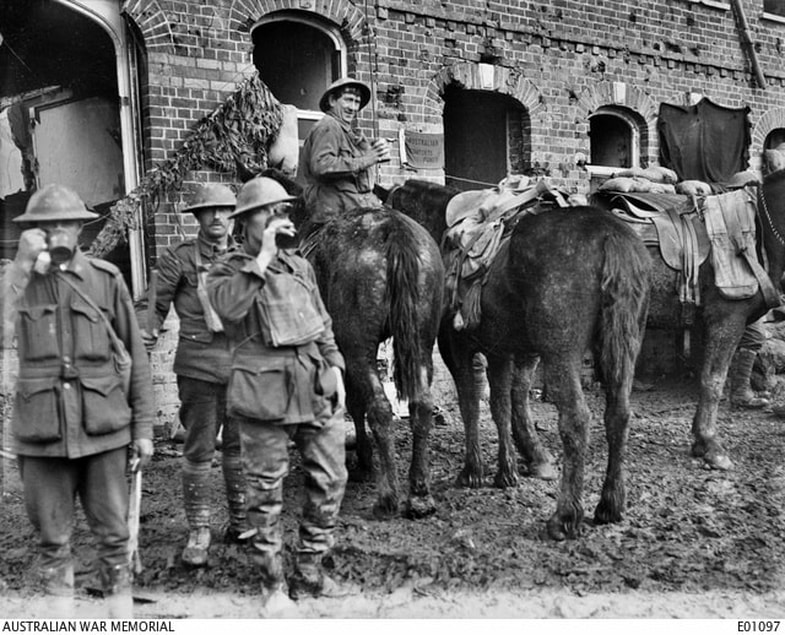
21st October 1917; Four unidentified artillery drivers of the 1st Division enjoying a cup of hot cocoa at the Australian Comforts' Fund Canteen on the Menin Road, in the Ypres sector. One is seated on his horse and the others are dismounted. The canteen has an 'Australian Comforts Fund' pennant over the door. The windows are all blown out.



